Consumers are savvy, informed, and empowered; they hold the keys that control the fate of your enterprise. Profit is a by-product of delivering value throughout all stages of the experience. Marketing initiatives and strategy are the keys to unlocking customer perception of value and, ultimately, the success of your business.
The way B2B enterprise has always been done doesn’t work anymore. Every touchpoint is an experience and needs to be thoughtfully crafted.
B2B marketing usually focuses on large-scale, complex solutions. Gartner’s research found that 77% of B2B buyers feel that making a purchase is very complicated or difficult, calling it “time-consuming” and even “painful.” Why? Because, while organizations have digitized their content and operations, they have not yet updated their strategy.
The Traditional Marketing Funnel is On Life Support

The traditional marketing funnel looks like an ice cream cone. The idea is to get people into the top of the funnel and progress them down to a buying decision.
However, contemporary marketing knows the B2B buyer’s journey is the same as a B2C buyer’s journey — it just involves more people. The buying journey progresses through four stages: Attract, Convert, Delight, Advocate. The potential customer’s buying journey needs to progress through these four stages; however, the potential customer is typically more than one person on behalf of a company, and their interest level is relative to their pain points and understanding of possible solutions.
In other words, customers have different points of resolution throughout their buying journey.
Customer Points of Resolution
There are three key buyer milestones: Awareness, Conversion, and Retention. Within the Awareness-to-Conversion process, potential customers will become aware and learn, then consider, evaluate, and even try before they buy. When the potential customer is Converted to being a customer, they will get started, develop, and use the solution. As a long-term customer (in Retention phase), the customer will share, refer, upgrade, and even become an advocate for the solution/company.
The key to all customer points of resolution in decision-making is innovating, transforming, and translating your brand into intentional and memorable experiences.
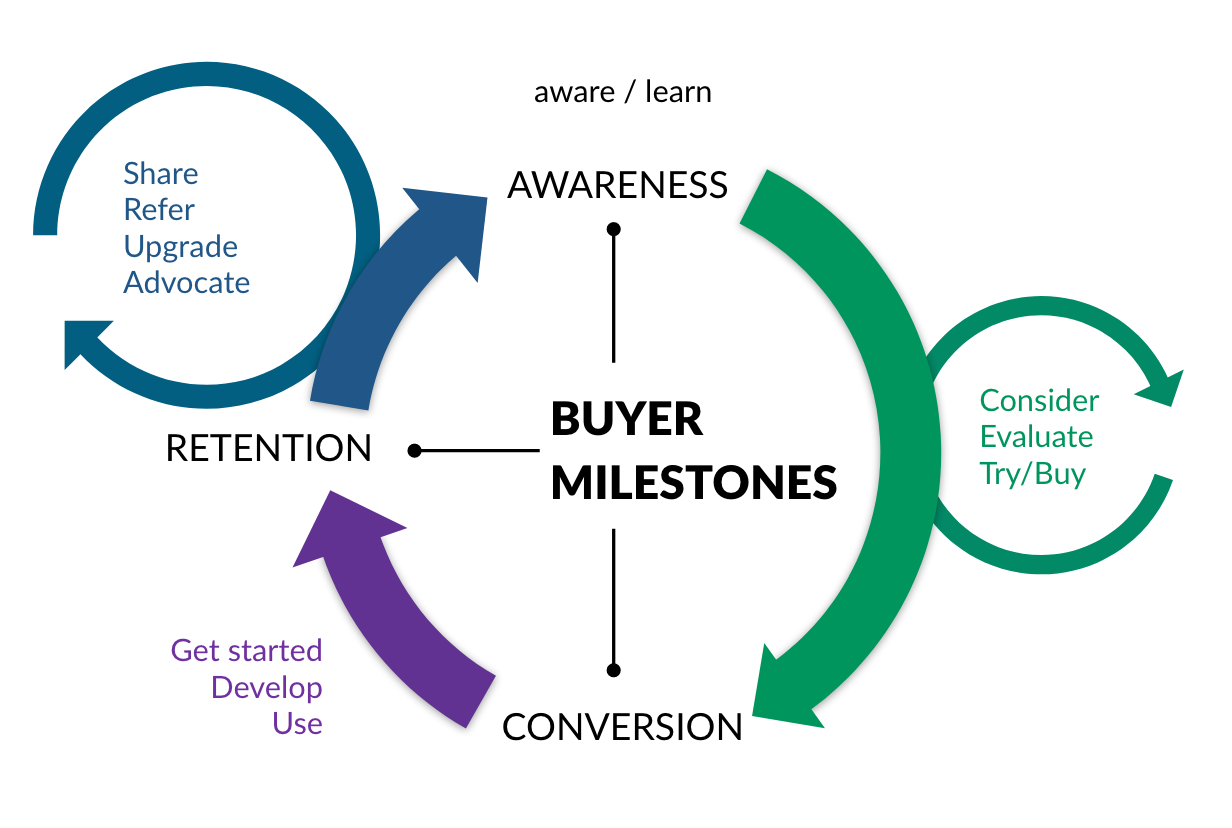
Going deeper into the points of resolution, the customer needs to move through six lenses of perception to buy into a specific solution: problem identification, solution exploration, requirements building, supplier selection, validation, and consensus creation.
This means the B2B marketer has corresponding performance targets — both strategy and action steps — which are designed to resolve questions and progress the potential customer through their points of resolution: demand generation (gen), lead gen, retention, and recovery.

Demand gen is what’s called “top of the funnel” strategy that creates an awareness of and interest in your product or service. Demand gen addresses the first three things B2B buyers need to make a buying decision: problem identification, solution exploration, and requirements building.
Lead gen is found in the middle and bottom of the traditional funnel marketing strategies that convert potential customer interest into action. Lead gen tactics solve the last three points of resolution for buyers to make a buying decision: supplier selection, validation, and consensus creation within the company for a particular solution.
Retention and advocacy are the loyalty loop, where one-time customers become repeat customers with upgrades and additions. The loyalty loop returns the customer to the beginning of their journey through identifying new problems, opportunities, and solutions. (More on the loyalty loop below.)
360 Degree Digital Marketing
The phrase, “360-Degree Digital Marketing,” places the buyer at the center of 10 key B2B marketing strategies as follows:
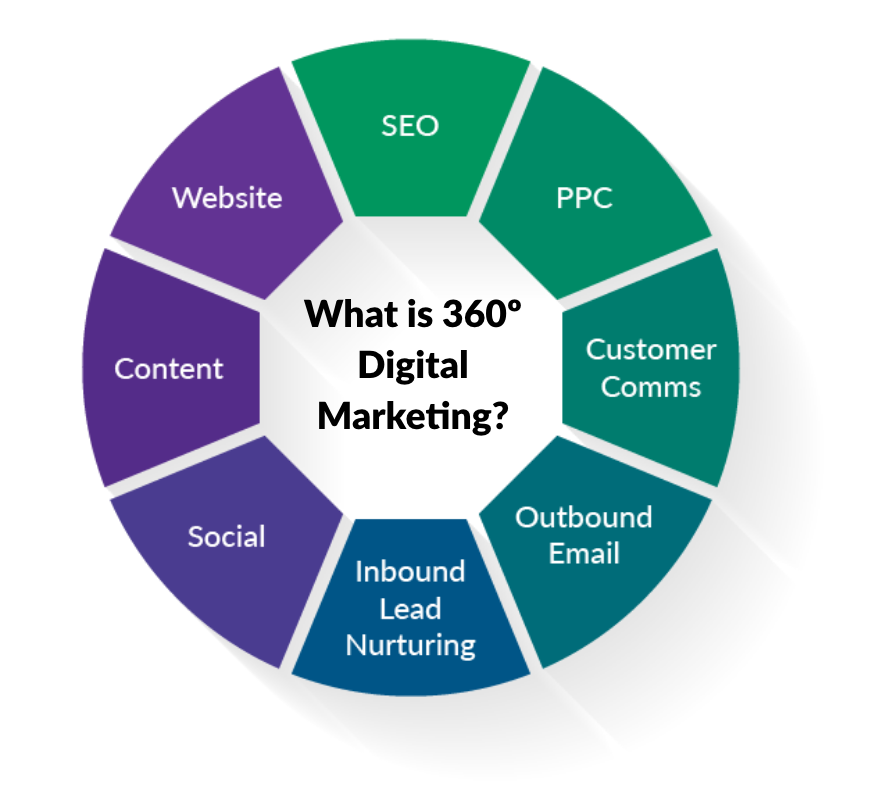
- A great website
- Social media marketing
- Video marketing
- Content marketing
- Search engine optimization (SEO)
- Pay-per-click advertising (PPC)
- Event marketing
- Affiliates and partnerships
- Remarketing/retargeting
- Marketing automation (including email marketing)
Each of these strategies could be its own book, and each can apply to more than one stage of the buyer’s journey. The most urgent priority is the first one: a great website. This is a primary source of information for potential customers.
In the B2B business environment, events help generate the most leads. Why? Today’s empowered buyer still wants to build relationships, and events are the best way to initiate and cultivate them. If can’t host an event, at least go to the ones relevant to your industry, and know who will be there.
B2B demand gen marketing makes companies and buyers aware of a problem they have, aware that a solution exists and that you have it and interested in learning more about your product or service. Following are the digital strategies that work best for demand generation:
- Display advertising
- Content marketing
- Video marketing
- Social media marketing (and advertising)
- Search engine optimization (SEO)
Content Marketing for Buyer Enablement
91% of B2B marketers use content marketing. However, “content marketing” is a huge term that includes blogs, news articles, social media, email workflows, videos, press releases, FAQs, newsletters, e-books, white papers, special reports, case studies, infographics, datasheets, and more.
A few key statistics about the B2B buying journey:
– More than half of all B2B buyers view at least eight pieces of content during the purchase process (more than 80% of buyers view at least five pieces).
– 75% of buyers say content significantly impacts their buying decision.
– 75% of buyers say social media content supports their buying decision.
– 71% of B2B purchase researchers begin researching with generic Google searches; researchers do an average of 12 searches before engaging with a specific brand’s site.
– 62% of buyers say they can finalize their purchase selection criteria based on digital content alone.
“Most companies build [content] strategies in the name of thought leadership, brand awareness, and personalization — focusing primarily on their own features and benefits. However, there’s significant commercial benefit for companies that focus their content on customers and helping them through the purchase process.“
– Martha Mathers, MVP, Gartner
I believe that, in the absence of content, you don’t have substantive marketing. Things can look pretty, but if they’re not providing narrative value, it’s not helpful.
So B2B marketers need to think “buyer enablement” for content — content that supports the completion of critical buying tasks. Think self-service: buyers want to know as much as possible before they have to talk to someone.
To build this type of content, marketing leaders need to:
1. Understand the decision points and tasks that buyers need to experience through the purchase journey.
2. Provide information and tools that target and address these specific tasks — think of it as a conversation.
3. Make the information available to buyers through their preferred channels — be where your buyers are already looking.
Gartner’s study found that currently, only about 20% of the information on B2B websites today displays characteristics of buyer enablement — which means a wide-open opportunity.
For demand gen, blogs and webinars are great. For lead gen, you’re solving for a different problem: conversion. In lead gen, you need to help buyers through supplier selection, validation, and consensus creation. The best content marketing pieces for this stage are case studies and credibility/authority-builders to help create buy-in from other stakeholders, like the CFO or buying committee. Other types of content that supports credibility:
– Testimonials and reviews
– Press coverage
– News releases
– Blurbs about awards and partnerships
– Anecdotes about your company’s culture, history, and core values
– Case studies
– Whitepapers
– Review sites
Here’s a statistic that breaks my copywriting heart: 7% of buyers say a lot of B2B content out there is useless. Instead, they want examples from customers/peers, content from credible sources, and short, digestible content.
What should you avoid in content marketing for buyer enablement? For me, that’s four things: 1) talking about yourself, 2) focusing on product features, 3) articles written by people lacking experience, and 4) long content (anything around or more than 2,000 words or more than three to five minutes in video).
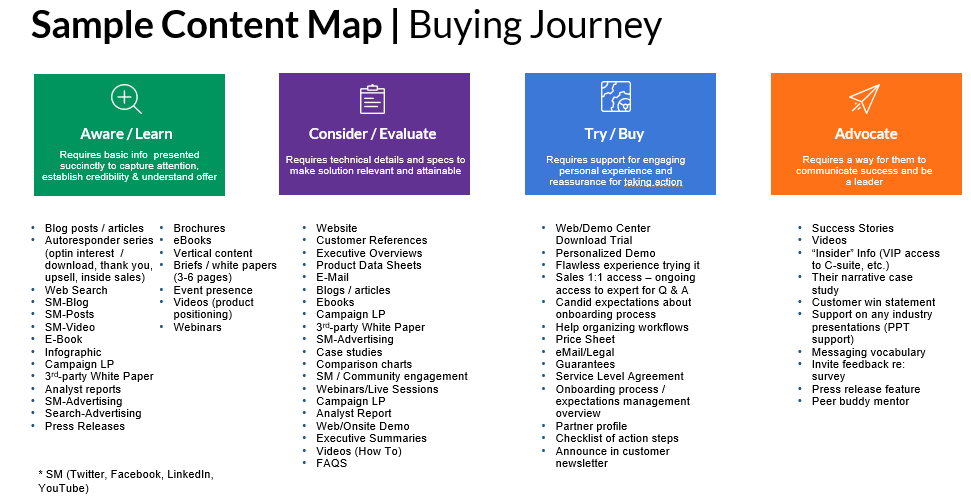
Elements of a Good Loyalty Loop
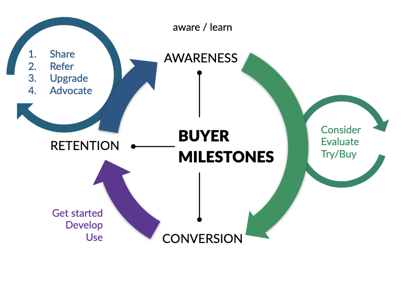
The loyalty loop is vital because some studies say it’s 350+% more profitable to sell to an existing customer than a new one.
A loyalty loop, essentially, has your customers who are satisfied with their original purchase decision and who then begin a new buying journey with your company via new awareness of a new product, need, solution, upgrade and/or addition to what they already have with you.
The top five types of content marketing for customer retention and the loyalty loop include:
1. Blogs
By seeing what’s new with your solution provider, you learn what’s possible for next-level business. The better the blogs, the more skills, and knowledge shared, the more value and credibility a provider has to reinforce the relationship.
2. eBooks and whitepapers
Empower your customers by educating them with substantive information and insight.
3. Social media
Be consistent in posting blogs, videos, articles, webinars, product updates, new solutions, customer success stories, and testimonials. Not only can that attract interest, it makes it easy for someone to simply forward or comment to one of the people they know, which can turn into a referral. Remember to use the 80/20 rule: post 80% information and 20% promotion.
4. Videos
Videos are great for visual types when it comes to retention and advocacy. Personally, I’m a reader. It takes too long for me to watch videos, but people learn in different ways, so you want to meet them there. You can repurpose your content — your blogs, interviews, white papers, success stories, and more — into attention-grabbing videos. Really, videos are good at all stages of the buying journey. Make sure you attribute them appropriately when you post them on Youtube to get maximum eyeballs on them.
5.Webinars
Webinars are a fantastic way to help customers consume your solution or be more adept with the solution you are providing them. Webinars are good for how-tos, interviews with other customers, Q & As, etc. Whether you pre-record or do them live, either way is effective.
In addition, I would add email marketing. Email marketing has a 4400% ROI and $44 for every $1 spent. It’s great with making sure your brand stays top-of-mind and help your existing customer base stay aware of new products, insights, and deals/savings from your company.
Some examples of good email marketing to cultivate the “loyalty loop” include:
- Monthly newsletters
- Blog newsletters
- Webinar notifications
- New service offering notifications
- Thank-you and culture-building emails
- Webinar announcements and reminders
- New e-book announcements
- Staff introduction emails
Where is Your Company in B2B Marketing?
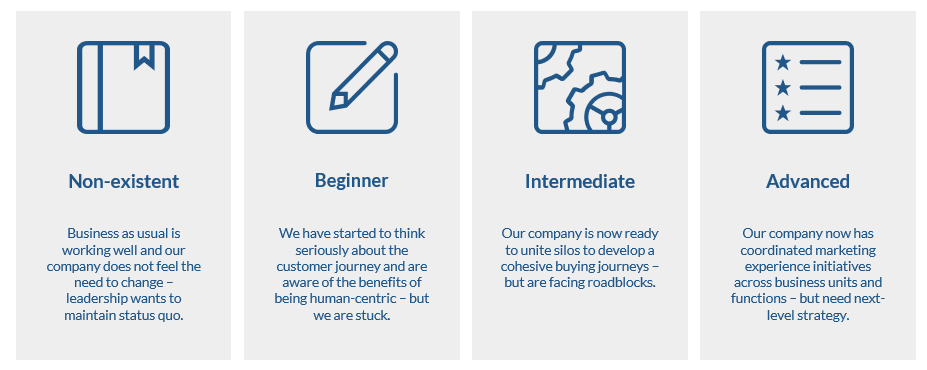
So where is your company in terms of understanding and actualizing B2B marketing and strategy? It’s essential to honestly assess this only because if you get too far ahead of where you are, it’s like alphabet soup; it just doesn’t make sense when your buyers and customers try to understand it.
Is B2B marketing and strategy a myth in your company? Or have you started to think about it, but got stuck when it came to operationalizing it? Do you know the questions to ask to develop a great B2B marketing strategy?
Are you ready to create more cohesion with your buying journeys but maybe have hit some barriers or obstacles? Maybe you’re rolling with some great marketing initiatives, but they aren’t pointing toward results. You need to think more strategically about where to put your resources. When you know where you are in your B2B marketing experience, you can use that as a launchpad for next-level marketing and strategy. Let the next level pull you forward in your strategic marketing initiatives.
5 Steps to Creating a B2B Marketing Strategy

There are five basic steps to creating a B2B marketing strategy: know your audience, SWOT yourself, call out your targets, match targets to stages of the buying journey to marketing strategies, then review to refine and then repeat.
Know your audience: A title or job role says nothing about how they behave, what motivates them to purchase, and how they react to certain marketing content. Different people are motivated and engaged by different things, not to mention that the modern B2B sales funnel involves more than one person. You need to know:
- Their general demographics
- Their general common interests
- Their motivations for using your product
- Their pain points that your product or service solves
- Their preferred method of communication (Do they use email more than social media? Do they watch more videos on YouTube or Facebook? Are they more likely to read an infographic or a white paper?)
SWOT: SWOT stands for assessing your strengths, weaknesses, opportunities, and threats in light of competitors. Why? Your growth reflects how your market perceives your value in contrast to your competitors. Know the environment your buyers are swimming in to uniquely position yourself.
Call out your targets: Where do you need to be in to lead the field against your competitors? Identify your targets, write them down, and review them often.
Match your targets to phases of the buying journey to marketing strategies: Once you’ve got your targets, you can match each one to the best B2B marketing strategies. For example, if your focus is on upselling or just keeping current customers, you need to focus on retention strategies. If you’re looking to increase leads, lead gen activities will take more resources. If you need to get more people aware of what you’re doing and get them in the proverbial door, it’s about demand gen.
Review, refine, repeat: Monitor what’s happening in your marketing campaigns, refine them based on what you learn from the results, then repeat the process. This means you leverage your experience to get better and better results.
Altogether, B2B marketing and strategy have shifted from being company-centric to customer-driven. Customers expect the product or service you offer to work the way you say it will—the differentiator is in how easy it is to work with you, how much your company reduces their friction in getting what they want and the emotional experience of your customer throughout the buying journey. Marketing and strategy define the parameters and hallmarks of that journey.
By listening to your customers, giving your customers the ability to choose their experience with you, and being prepared to meet them where and how they choose, you deliver a compelling, personal buying experience. And that is the perception that changes everything for both your customers and your company.

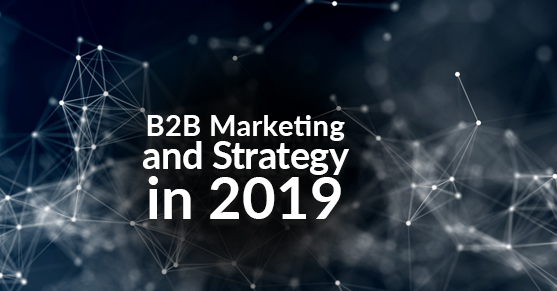
Hello, Awesome Article, and Your information is very amazing and so much useful for me. Keep it up and thank you very much.:)